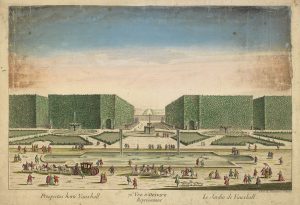
I no sooner entered, than I was dazzled and confounded with the variety of beauties that rushed all at once upon my eye. Imagine to yourself picturesque and striking objects; pavilions, groves, grottoes, temples, and cascades. Eyecatchers. Each one a theatre, an unnatural assembly of objects seemingly contrived to dazzle the eyes and divert the imagination. The whole fantastically illuminated with infinite lamps, arrayed in unfathomable galaxies of suns, stars, and constellations.
A pleasure garden is an extraordinary business, a cradle of ingenuity and curious devices, a fount of architecture, art, games and music. However, underlying these elements is the real secret of its success, the fundamental ingredient, a particular blend of continuity and novelty. (Smollett, 1785, Barrell, 2012, Addison, 1712)
Context
This year we will be designing buildings for Vauxhall Pleasure Gardens, by the River Thames in London. Vauxhall Pleasure Gardens existed for 198 years from 1661 to 1859 through times of great change. The old world became new, the familiar made strange. Advances in science, technologies, architecture, art, philosophy and politics brought together the near and far, the infinitesimal and the galactic, the past and the future. The Pleasure Gardens had to become a generator of great experimentation and novelty, a place where the new could be seen and heard. At their considerable zenith they were one of the largest and most complex businesses in Britain, innovating at scale across many fields.
Nine elements
During your initial three-week detailed study you will compose a suite of nine architectural elements as a complex ecology of interacting parts. These will be developed from the careful consideration and design of the nine elements, which are: foundations, walls, doors, windows, roof, ceilings, floors, corridors and thresholds.
Time-Based
Buildings have often been studied whole in space, but never before have they been studied whole in time. We propose that buildings adapt best when constantly refined and reshaped by their occupants, and that architects can mature from being artists of space to artists of time. The word building contains the double reality. It means both action of the verb ‘build’ and ‘that which is built’ – both verb and noun, both action and the result. Whereas architecture may strive to be permanent, a ‘building’ is always building and rebuilding. Could the idea be revised to match the fact? (Brand, 1994)
During the initial three-week detailed study students will have to decide: over what periods of time does their architecture operate? What would be the triggers in space? Will you as a designer take on a different role as an ‘editor of situations’ and ‘readers of spaces’ at different levels of detail in the design? Your design project can take the form of a specific event at a certain period of time that you record and communicate.
Each student will develop their design research project through discovery from analysis of the site context which will then be developed into a small building in a complex urban environment. This will be done during the first three-week detailed study.
Unit seven focuses on preparing you for practice through our studios, careful research with close-study and collaboration amongst the units student research clusters. The research clusters will be formed based upon the outcomes of your research.
Year Two
Your projects will be highly speculative and risk taking proposals for a high-street building on Kennington Lane. Every student will develop a personal architecture through your drawings and modelling. After your initial three-week detailed study, we will put you into a research cluster composed of masters students from unit twenty-one and undergraduate students from unit seven to focus your area of research by design.
Year Three
Your projects will be complex and ambitious research building proposals for the Vauxhall Pleasure Gardens. You will individually develop a clear planning proposal by Christmas and you are encouraged to use your dissertation to advance your understanding of design. After your initial three-week detailed study, we will put you into a research cluster composed of masters students from unit twenty-one and undergraduate students from unit seven to focus your area of research by design.
References
Smollet, Tobias, 1785. The Expedition of Humphry Clinker. London: Harrison & Co.
Barrell, John, 2012. The English Pleasures of Vauxhall. TLS, [online] Available at:<http://www.the-tls.co.uk/articles/public/the-english-pleasures-of-vauxhall/> [Accessed 4 September 2016].
Addison, Joseph, July 2nd 1712. Spectator No. 420. London: Addison, Steele.
Brand, Stewart, 1994. How Buildings Learn: What Happens After They’re Built. London: Penguin Books.